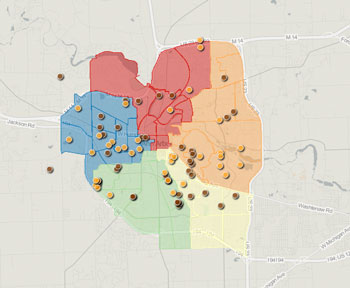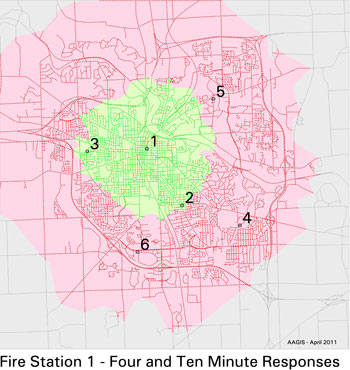City Council Campaign Finance Crosses Wards
A preliminary analysis of pre-primary campaign finance reports for the four contested races in the Aug. 7 Ann Arbor city council Democratic primary shows a total of $53,050.25 in cash was raised by the eight candidates combined, with the average donor contributing a bit over $100.

Shaded areas indicate Ann Arbor’s five wards. Colored dots denote the address of a donor to a campaign – brown for one candidate and orange for the other candidate. Which ward’s race does this map show? Details below.
The two candidates in Ward 5 raised a combined total greater than any other ward – with Chuck Warpehoski raising $9,558 and Vivienne Armentrout receiving about $2,000 more, at $11,350. Warpehoski’s total came from a significantly greater number of donors than Armentrout’s contributions, but were on average much smaller. Armentrout and Warpehoski are competing for the Democratic nomination and will face Republican Stuart Berry in November. Sitting Ward 5 Democrat Carsten Hohnke decided not to seek re-election.
Raising slightly less than Ward 5 candidates were incumbent Ward 2 councilmember Tony Derezinski ($8,475) and challenger Sally Petersen ($7,947). The distribution of donation sizes was similar for the Ward 2 candidates, and both showed a much higher per-donor average than the citywide figure – $163 for Derezinski and $139 for Petersen.
In Ward 4, Democratic primary voters will have the same choice they had in 2010 – between incumbent Margie Teall and challenger Jack Eaton. This year, they have raised roughly the same amount of money – Teall with $4,685 and Eaton with $4,305.
Ward 1 showed the greatest difference in the amounts raised by the two candidates, as Sumi Kailasapathy raised about 70% more than Eric Sturgis – $4,220 compared to $2,510 for Sturgis. The seat will be open because Sandi Smith is not seeking re-election.
A common theme across all the campaign finance reports is the significant support candidates receive from outside the ward they’re seeking to represent. That’s a trend visible in the maps we present after the jump.
Part of that trend can be explained by the number of city residents who donate money to more than one campaign. Out of the nearly 500 different donors across the eight campaigns, 58 donated to two or more campaigns, and 23 donated to three or more. The Chronicle counted nine donors who contributed to four different city council campaigns.
Many observers perceive a grouping of candidates based on shared basic philosophies – Kailasapathy, Petersen, Eaton and Armentrout on the one hand, contrasted with Sturgis, Derezinski, Teall and Warpehoski. While there’s likely considerable room for disagreement about what the common thread is that ties those candidates together, the multiple-campaign donors bear out a perception of some commonality: Of the 58 multiple-campaign donors, all but three squared up with that candidate grouping.
The three donors identified by The Chronicle as flouting that grouping included 22nd circuit court judge candidate Carol Kuhnke, who gave money to both Ward 2 candidates (Derezinski and Petersen) as well as Sturgis and Teall. Past Ward 2 candidate Stew Nelson gave money to Petersen and to Sturgis. And former Ann Arbor Downtown Development Authority board member Ed Shaffran donated to Teall and to Armentrout.
Which group had more multiple-campaign donors? There the nod goes to the group with no incumbents – Kailasapathy, Petersen, Eaton and Armentrout – with 39 of the 58 multiple-campaign donors. [Full Story]




